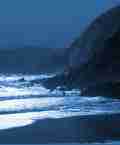 |
Search the site:

MAYOStanding on the edge of Croaghaun, it was difficult to believe that I was now on the edge of the highest sea cliffs in the British Isles, where the mountain suddenly comes to an end and falls 1,950 feet to the sea in a series of vast, rocky, partly grass-grown slopes. It was difficult to believe because beyond twenty feet in any direction, up, down, or sideways, it was impossible to see anything at all. All I could hear was the sea sighing far below, and the dismal crying of the gulls.Croagh Patrick (764 metres/2,510 feet) (route 80) dominates Clew Bay from the south as a ridge eight kilometres/five miles in length and provides excellent views of its sea-truncated drumlins. It has a fine, distinctive cone, but as a pilgrimage mountain the wide, ugly track leading to the summit and the ecclesiastical constructions on the summit do nothing to enhance it. The mountains of South Mayo are generally more demanding than those farther north. The sandstone massif of Mweelrea (814 metres/2,688 feet) (route 81) lies directly north of the long, sinuous fiord of Killary Harbour. Commanding excellent views of ocean and mountain, it is a small but most attractive area, especially around the stern and forbidding gigantic corrie which truncates the north-eastern side of the massif. Unfortunately, this side is particularly badly depicted on the one available map (see below). Immediately to its east, the Ben Corm group (700 metres/2,303 feet) (route 82) is another fine walking area, especially on its western side where it overlooks the sylvan pass at Delphi. The Sheeffry Hills (route 83), to the Ben Gorm group's north, are mostly flat uplands, though they have impressive corries on their northern flanks and a good east-west ridge walk at the western end. The Partrys and ]oyce Country comprising the triangle of hills east of the N59 and the R336 lie only partly in Mayo but are included here for convenience. The main feature is the Devilsmother (645 metres/ 2, 131 feet) (route 84) at the western apex of the Partrys, which in spite of its threatening name offers lovely views along Killary Harbour. Of the rest of the Partrys, the corries that almost surround Maumtrasna (673 metres/2,207 feet), especially around Lough Nadirkmore (route 85) and the area north of Lough Nafooey, are rugged and scenic. However, the higher ground and the long north-east spur of this range are mostly wet, flat bogland. The part of Joyce Country directly to the north-east of the R336 (route 86) has nicely formed and, unusual for this area, grassy hills. Its south-west side falls in smooth slopes to the R336, with its spurs enclosing, in places, small secret valleys. Access: Westport is about 260 kilometresl160 miles from Dublin, and Larne is about 340 kilometresl2l0 miles away. The region is not easily accessed and within the county even primary roads are not good. Knock Airport, in east Mayo, has regular flights to Dublin. A train service runs as far as Westport. A summer-only express bus service goes from Galway through Clifden and Leenane to Westport and another runs along the north side of Clew Bay. Other all-year express services run to Westport. The next 'Mayo' extract can be found here : Part 3 The previous 'Mayo' extract from Walking Ireland's Mountains can be found here: Part 1
|
[ Back to Top ]
All Material © 1999-2009 Irelandseye.com and contributors
